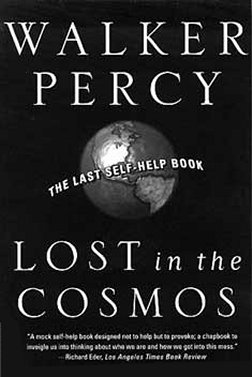

|
<<< Continued from previous page The key fact about the true first edition of SSM is that each copy is clearly denominated as "first edition" on the copyright page; the later printings from 1948 have no printing indication; printings from later years are so indicated. The second most important point is that the dust jacket has a price of "$3.00" on the top of the front flap; the price was quickly raised to $3.95 and then $4.95. Seems simple enough, but there are some bibliographic complications that have made collecting SSM a bit more challenging:
Walker Percy, Lost in the Cosmos: The Last Self-Help Book (First edition: New York, Farrar Straus Giroux, 1983)

Walker Percy's major nonfiction book is a hilarious parody of the 1980s' self-help books, pop science like Carl Sagan's Cosmos, and TV chat shows (his target then was Phil Donohue; today, of course, it would have been Oprah Winfrey), but also a serious exploration of Percy's interests in semiotics and Christian existentialism (there is a small but serious group of scholars who acclaim Percy [1916-1990] as one of the most important American philosophers of the latter half of the twentieth century). By 1983, Percy was a major literary personage and his books - too few novels for a 30-year career - were major events. In other words, many, many copies (35,000 in fact) of the first edition of Lost in the Cosmos were printed. So it's not a rare book, and thus I was not troubled some time last year when looking at my shelf I saw my books by Walker Percy and realized that I no longer had a copy of Lost in the Cosmos. I read it when it was published and enjoyed it, so I thought to myself that I should get another copy of it - not a difficult task. Within a week of that thought, I was doing a little scouting at a local thrift, and, as I passed the second bookcase in the back of the store, I saw a copy of Lost in the Cosmos jammed in at the bottom. Ah-ha, I thought, I can make that (re)acquisition right now. The book was a little worse for the wear, but when I opened it up I had the nice surprise to see that it was a first, signed by Percy above his name on the title page, a helpful reminder both that the apparent condition of a book should not be the last word on its value and that a very common $1 book may often hold a $100+ surprise inside.
 If you liked this article, Digg it!
-
If you liked this article, Digg it!
-
< to previous article to next article >
Questions or comments?
| Forum
| Store
| Publications
| BookLinks
| BookSearch
| BookTopics
| Archives
| Advertise
| AboutUs
| ContactUs
| Search Site
| Site Map
| Google Site Map
Store - Specials
| BookHunt
| BookShelf
| Gold Edition & BookThink's Quarterly Market Report
| DomainsForSale
| BookThinker newsletter - free
Copyright 2003-2011 by BookThink LLC
|

|
|